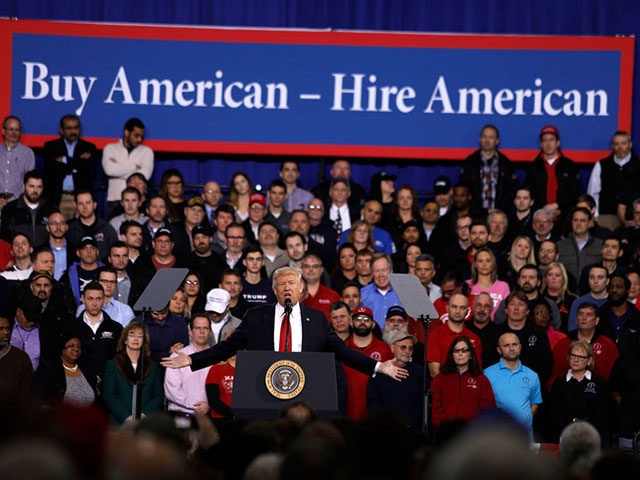President Donald Trump’s “Hire American,” low-immigration policy is giving American employees a larger share of company profits, so the federal government should raise the supply of foreign workers, according to a mournful editorial column in the Wall Street Journal.
“Corporate profits have been declining as employers increase wages to hire scarce blue-collar workers … corporate profits could soon drop to historic lows, which could reduce business investment and GDP growth,” says the editorial board’s complaint, titled “America’s Disappearing Workers.”
“Maybe the only short-term fix is to increase legal immigration—unless Americans want to see their living standards decline and more jobs exported,” the editorial concluded.
The nation’s workforce includes at least 164.6 million workers. None of those workers are “disappearing,” and CEOs are free to solve their labor shortages by recruiting workers from nearby companies.
However, CEOs are loath to start a bidding war for workers — even though the CEOs are very eager to see workers bid against each other for jobs by offering to accept lower wages or irregular scheduling.
The proposed policy of endless migration to keep wages low is being pushed by nearly all of the Democratic candidates for president. In contrast, Trump is running TV ads boasting of rising wages amid a “Blue Collar Boom”:
"This is a blue-collar BOOM!"—@realDonaldTrump
#KAG pic.twitter.com/C9rbA2qNd4— GOP (@GOP) January 15, 2020
The WSJ editorial first admitted the good news about the supply, demand, and price of labor:
Many working-age men who dropped out of the workforce during the recession and early years of the recovery are relying on parents and government. Nearly 12% of 25- to 64-year-olds in Kentucky are not in the workforce because they claim a disability. Almost a quarter of 25- to 34-year-old men without a four-year degree live with their parents—twice as many as those with a bachelor’s.
The good news is that a tight labor market is accelerating wage growth most for lower-skilled and young workers. Wages for 20- to 24-year-olds are increasing twice as fast as for other workers. Many companies are also recruiting more women and minorities and sweetening benefits.
But even amid the inflow of sidelined workers, U.S. companies still don’t have enough workers, complained the editorial.
90% of blue-collar businesses report operating with unfilled positions, and 29% say this has made them reduce output or turn down business. Rising wages together with sluggish productivity growth are crimping corporate profits. Between the fourth quarter of 2014 and the second quarter of 2019, profits for nonfinancial corporations declined 17% and 46% for manufacturers.
On current trend, corporate profits could soon drop to historic lows, which could reduce business investment and GDP growth. “The US will not be able to maintain its current standard of living unless the US government acts to significantly increase immigration, improve labor force participation, and, together with employers, raise labor productivity growth,” the Conference Board warns.
The WSJ column cites the worker shortage claims from a business group, the Conference Board. In turn, the board’s Committee for Economic Development urges more white-collar migration for healthcare jobs:
To achieve greater economic prosperity and address labor shortages, CED recommends:
…
Improving H-1B visa criteria to admit more workers in occupations with labor shortages … Immigrants in computer-related occupations, where there is currently lower risk of labor shortages, dominate H-1B admissions. In contrast, occupations requiring health services or statistical and mathematical analysis face labor shortages that will continue to grow if left unaddressed.
Lobbyists for investors like to argue that immigration swells the economy and profits without cutting Americans’ wages and without spiking their housing costs.
The globalists' community newspaper, the Economist, admits that lower blue-collar migration means higher wages for Americans, and the higher wages also stabilize the US economy.https://t.co/nqOsMiBwg7
— Neil Munro (@NeilMunroDC) February 19, 2020
But an increasing number of experts are grudgingly admitting that Trump’s reduction to migration is boosting Americans’ average wages, the government’s tax receipts, and politicians’ reelection chances.
The lesson has been admitted by independent academics, the National Academies of Science, the Congressional Budget Office, executives, more academics, New York Times reporters, state officials, unions, more business executives, lobbyists, employees, the Wall Street Journal, federal economists, Goldman Sachs, oil drillers, Wall Street analysts, fired professionals, legislators, construction workers, New York Times subscribers, Robert Rubin, and even by the Bank of Ireland.
However, American graduates have yet to see any cutback in white-collar migration, or any boom from Trump’s Hire American economic policies.
Govt data shows 1 million Indian contract-workers get white-collar jobs in tech, banking, health etc.
The Indian hiring ignores many EEOC laws & is expanding amid gov't & media silence.
It is a huge economic & career loss for US college grads.#S368 #H1B https://t.co/pqEW9yJ89c— Neil Munro (@NeilMunroDC) February 17, 2020

COMMENTS
Please let us know if you're having issues with commenting.